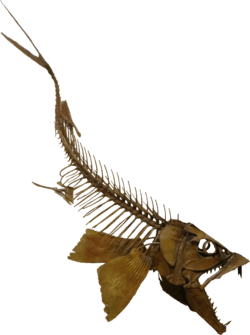Enchodus
Enchodus is an extinct genus of aulopiform ray-finned fish related to lancet- and lizardfish. Species of Enchodus flourished during the Late Cretaceous, and survived the Cretaceous–Paleogene extinction event, persisting into the late Eocene.
| Enchodus | |
|---|---|
 | |
| E. petrosus mounted skeleton cast in the Rocky Mountain Dinosaur Resource Center in Woodland Park, Colorado | |
| Scientific classification | |
| Kingdom: | |
| Phylum: | |
| Class: | |
| Subclass: | |
| Order: | |
| Suborder: | Aleposauroidei |
| Family: | †Enchodontidae |
| Genus: | Enchodus Agassiz, 1835 |
| Species | |
| |
Taxonomy
Species of Enchodus are generally classified into two different clades, the North American and the Mediterranean. It has been proposed that this distinction is the result of several isolated events between the two populations over the Late Cretaceous.[5]
| Enchodus[5] | ||||||||||||||||||||||||||||||||||||||||||||||||||||||||||||||||||||||||
| ||||||||||||||||||||||||||||||||||||||||||||||||||||||||||||||||||||||||
| Phylogeny of the genus with some species |
Description
Enchodus species were small to medium in size. One of the genus' most notable attributes are the large "fangs" at the front of the upper and lower jaws and on the palatine bones, leading to its misleading nickname among fossil hunters and paleoichthyologists, "the saber-toothed herring". These fangs, along with a long sleek body and large eyes, suggest Enchodus was a predatory species.
The largest-known species of Enchodus is E. petrosus, remains of which are common from the Niobrara Chalk, the Mooreville Chalk Formation, the Pierre Shale, and other geological formations deposited within the Western Interior Seaway and the Mississippi Embayment. Large individuals of this species had fangs measuring over 6 centimetres (2.4 in) in length, though the total body length was only about 1.5 metres (4 ft 11 in), giving its skull an appearance somewhat reminiscent of modern deep-sea fishes, such as anglerfish and viperfish. Other species were considerably smaller, some like E. parvus were only some centimeters (a few inches) long.
Despite being a formidable predator, remains of Enchodus are commonly found among the stomach contents of larger predators, including sharks, other bony fish, mosasaurs, plesiosaurs and seabirds such as Baptornis advenus.
Distribution
Enchodus fossils have been found all over the world. In North America, Enchodus remains have been recovered from most US states with fossiliferous Late Cretaceous rocks, including Kansas, Nebraska, Colorado, Alabama, Mississippi, Georgia, Tennessee, Wyoming, Texas, California, North Carolina, and New Jersey. Fossils also have been found in the Aguja and El Doctor Formations of Mexico and the Ashville, Vermillion River and Dinosaur Park Formations, and Brown Bed Member of Canada. The taxon is also known from coeval strata in Africa, the Middle East, Europe, southwest Asia and the Tiupampan Santa Lucía Formation and Maastrichtian El Molino Formation of Bolivia and the Paraíba, Pernambuco and Sergipe states of Brazil.[2]
Gallery
 Restoration of E. petrosus
Restoration of E. petrosus E. lewesiensis skull
E. lewesiensis skull- Teeth of E. elegans from Khouribga
- Teeth of E. libyus from Khouribga
References
- The Sabre-Toothed Fish of the Cretaceous
- Enchodus at Fossilworks.org
- Global Names Index
- "Mundo Fosil". Archived from the original on 2014-11-14. Retrieved 2015-05-13.
- Waymon L. Holloway; Kerin M. Claeson; Hesham M. Sallam; Sanaa El-Sayed; Mahmoud Kora; Joseph J.W. Sertich; Patrick M. O’Connor (2017). "A new species of the neopterygian fish Enchodus from the Duwi Formation, Campanian, Late Cretaceous, Western Desert, central Egypt". Acta Palaeontologica Polonica. 62 (3): 603–611. doi:10.4202/app.00331.2016.
Further reading
- Cope, Edward Drinker (1874): Review of the Vertebrata of the Cretaceous period found west of the Mississippi River. U. S. Geological Survey of the Territories, Bulletin 1(2): 3-48.
- Everhart, Mike (2007): Oceans of Kansas: Enchodus sp. - The Sabre-Toothed Fish of the Cretaceous. Version of 2007-MAY-29. Retrieved 2007-AUG-23.
- Russell, D. A. (1988): A check list of North American Marine Cretaceous vertebrates including fresh water fishes. Occasional Paper of the Tyrrell Museum of Palaeontology #4.
- Davis, Matthew P.; Fielitz, Christopher (2010). "Estimating divergence times of lizardfishes and their allies (Euteleostei: Aulopiformes) and the timing of their deep-sea adaptations". Molecular Phylogenetics and Evolution. 57. doi:10.1016/j.ympev.2010.09.003.
External links

- Introduction to Paleontology